

Table of Contents
Try Testkube instantly in our sandbox. No setup needed.
Try Testkube instantly in our sandbox. No setup needed.




Table of Contents
Executive Summary
According to a recent study, only 21% of QA professionals have implemented continuous testing into their development or release processes. This highlights a significant gap and an opportunity for businesses to adopt continuous testing and TestOps — two critical components in modern software delivery pipelines. These practices are essential for catching bugs early, streamlining releases, and meeting evolving business goals in cloud-native environments.
In this post, we’ll explore the pitfalls of traditional testing approaches and how integrating TestOps and continuous testing into your CI/CD pipelines can dramatically improve software quality and delivery speed.
Common Pitfalls of Traditional Testing Practices
While traditional testing methods were once effective, they now struggle to keep pace with modern CI/CD pipelines, cloud-native applications, and agile release cycles. By comparison, TestOps engineers and continuous testing workflows are designed to meet the velocity and complexity of today’s development processes.
Let’s examine where traditional testing still falls short:
Limited Coverage with Manual Testing
Manual testing is prone to human error, often lacks repeatability, and fails to provide full application coverage. It simply can’t keep up with the pace of modern software development. During high-pressure release cycles, relying solely on manual testing increases the chance of missed bugs, delayed releases, and negative user experiences.
Sporadic Testing Practices
In many legacy setups, testing occurs only near the end of the development lifecycle. This outdated practice leads to “defect slippage,” where issues are caught too late to resolve without delays. According to IBM's Systems Sciences Institute, a bug found during testing costs 15x more to fix than one caught during design — and 100x more once it hits production.
Business Impact of Poor Testing
Poor testing practices have real business consequences: increased customer churn, growing support costs, lost revenue, and a damaged brand reputation. A PwC survey found that 32% of customers would abandon a trusted brand after a single negative experience.
Traditional methods can no longer support the fast, iterative nature of modern development. To remain competitive, organizations must adopt TestOps practices and continuous testing tools that support speed, accuracy, and quality.
What Is Continuous Testing?
Unlike traditional testing, continuous testing is the practice of running automated tests throughout every stage of the software development lifecycle. Unlike traditional approaches, continuous testing integrates directly into CI/CD pipelines, ensuring faster feedback and reducing the risk of bugs reaching production.
This modern approach supports:
- Real-time bug detection
- Automated feedback loops
- Testing environments that mirror production systems
By leveraging automation and modern testing tools, continuous testing increases coverage, speeds up test cycles, and delivers more consistent results.

Key Principles of Continuous Testing
- Continuous Feedback Loops: Immediate feedback helps teams resolve issues before they escalate. Testing at each step of the CI/CD process means teams can iterate quickly without sacrificing quality.
- Production-Like Testing Environments: Creating test environments that match production helps simulate real-world behavior, leading to more accurate results.
- Proactive Defect Identification: By continuously running tests, teams can identify bugs early and reduce technical debt — a core principle of any effective TestOps strategy.
What Is TestOps?
While Continuous Testing emphasizes the integration of testing throughout the development process, TestOps brings DevOps principles to the world of software testing. Where continuous testing focuses on automation, TestOps takes a broader view — emphasizing collaboration, process orchestration, and shared ownership between QA, development, and operations teams.
In the TestOps vs DevOps debate, think of TestOps as quality-focused DevOps — designed specifically to improve test automation, reliability, and collaboration.

Key Principles of TestOps
- Automated Test Orchestration: TestOps engineers manage test execution as part of the CI/CD pipeline, treating tests like code to ensure repeatability and scalability.
- Testing as Code: Version-controlled test scripts allow for easier tracking, rollback, and auditing of testing changes — a key advantage over traditional test management.
- Cross-functional Collaboration: By breaking down silos between QA, developers, and operations, TestOps enables collective ownership of quality across the organization.
How Continuous Testing and TestOps Improve CI/CD Pipelines
Adopting TestOps and continuous testing leads to:
Faster Time-to-Market
Catching bugs earlier in development shortens feedback loops and prevents delays — helping you deliver faster without compromising quality.
Higher Product Quality
Automated testing tools and TestOps practices improve test coverage and reduce technical debt, ultimately leading to better software and fewer support issues.
Increased Team Efficiency
TestOps allows teams to focus on high-value work by automating repetitive test tasks and streamlining workflows within CI/CD pipelines.
Cost Reduction
Early bug detection and reduced reliance on manual testing contribute to long-term cost savings — both in labor and infrastructure.
Integrating Testkube for Scalable TestOps
To unlock the full benefits of TestOps and continuous testing, teams need the right tooling. That’s where Testkube comes in.
Testkube is a Kubernetes-native testing framework that supports modern testing workflows by integrating with your CI/CD tools, orchestrating test runs, and enhancing reporting — all while supporting your existing test tools.
Key Testkube Features:
- GitOps Integration: Manage tests, configurations, and environments as code.
- CI/CD Compatibility: Works with Jenkins, GitHub Actions, Azure DevOps, and more.
- Advanced Test Orchestration: Automate test runs, manage approvals, and sync with version control.
Read our blog posts on Testkube + ArgoCD and Testkube + ArgoRollouts to learn more about GitOps workflows for testing.
Testkube integrates with popular CI/CD tools such as Jenkins, GitHub Workflows, and Azure DevOps. Check out our complete list of supported CI/CD tools.

Summary: Why TestOps and Continuous Testing Matter
As applications move toward cloud-native architectures, traditional testing no longer delivers. TestOps engineers and modern continuous testing tools are essential for building resilient, scalable software in a CI/CD-driven world.
By embracing TestOps vs DevOps as complementary — not competitive — approaches, businesses can achieve:
- Faster, safer deployments
- Higher customer satisfaction
- Lower operational costs
- More collaborative engineering teams
Testkube is purpose-built to help you bridge this gap. Sign up today for your free trial to learn how we can power your shift to TestOps and continuous testing.


About Testkube
Testkube is a cloud-native continuous testing platform for Kubernetes. It runs tests directly in your clusters, works with any CI/CD system, and supports every testing tool your team uses. By removing CI/CD bottlenecks, Testkube helps teams ship faster with confidence.
Explore the sandbox to see Testkube in action.






